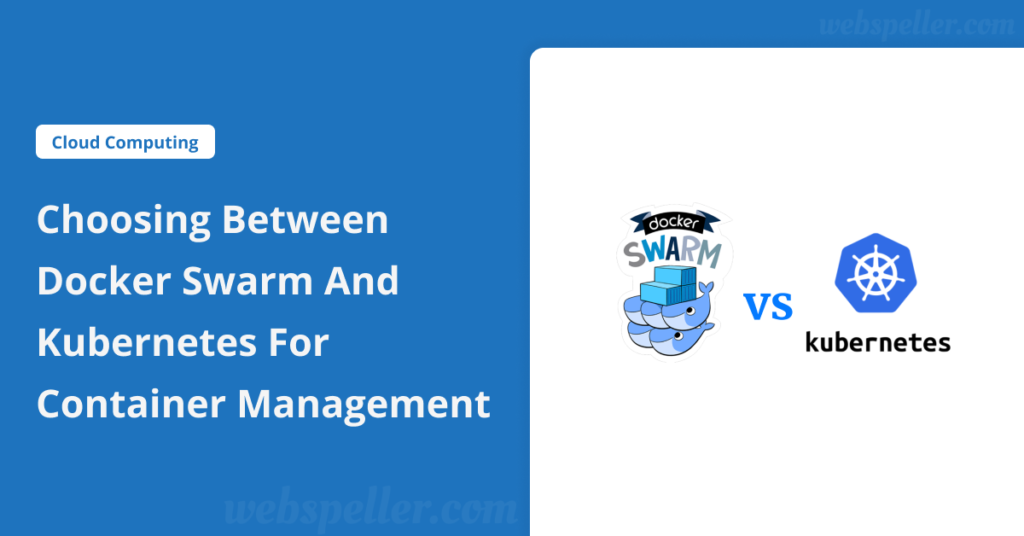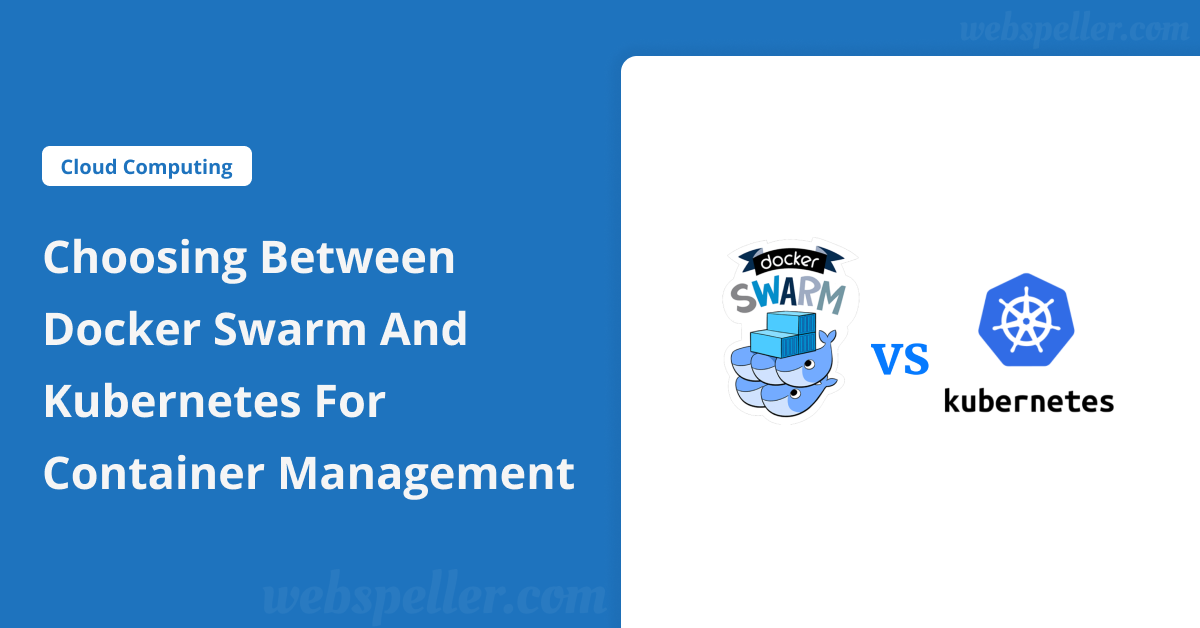
Table of Contents
Introduction
Choosing the right container orchestration tool between Kubernetes and Docker Swarm depends on multiple factors, including project complexity, team expertise, and future scalability needs. Both tools are popular for managing containers but have different strengths and use cases. Here’s a comprehensive breakdown of Kubernetes and Docker Swarm to help you make an informed decision.
What is Kubernetes?
Kubernetes is an open-source platform designed to automate the deployment, scaling, and management of containerized applications. Initially developed by Google, it has become the industry standard for container orchestration. Kubernetes simplifies managing containers across clusters of machines, ensuring applications run efficiently and reliably.
Key features of Kubernetes include service discovery, load balancing, storage orchestration, and automated rollouts and rollbacks. Its ability to maintain a desired state for applications—automatically adjusting to resource requirements—makes it a powerful tool for large-scale deployments.
What is Docker Swarm?
Docker Swarm is a container orchestration tool integrated within the Docker ecosystem. It focuses on simplicity and ease of use, making it a great choice for teams already using Docker. Docker Swarm allows you to manage a cluster of Docker engines as a single virtual engine, simplifying container management for smaller-scale applications.
Swarm provides basic functionalities like container scheduling and networking, making it an attractive option for those starting with containerization. Its tight integration with Docker commands ensures a low learning curve and smooth operation.
Kubernetes Advantages
- Extensive Functionality: Kubernetes offers a wide array of features such as auto-scaling, self-healing, and declarative configuration management. This allows for complex, high-availability deployments.
- Unified API and Cluster State Guarantees: Kubernetes ensures a consistent cluster state through its API, making it easy to automate deployments and manage containerized systems.
- Strong Community Support: With a large and active community, Kubernetes benefits from a rapidly evolving ecosystem, including tools and extensions that simplify deployment.
Kubernetes Drawbacks
- Complexity: Kubernetes’ extensive features can be overwhelming, especially for smaller teams or projects. The platform requires significant technical expertise to set up and manage.
- Frequent Updates: While Kubernetes provides new features regularly, keeping up with updates can be time-consuming.
- Overhead for Small Projects: The infrastructure and management effort required to run Kubernetes may not justify its use for smaller, simpler applications.
Docker Swarm Advantages
- Native Docker Integration: Docker Swarm offers tight integration with Docker, making it easy to scale existing Docker applications with familiar commands.
- Simplified Networking: Swarm’s networking model is straightforward, enabling quick deployment and basic load balancing across containers.
- Intelligent Scheduling: Swarm automatically assigns containers to nodes based on available resources, ensuring efficient resource utilization.
Docker Swarm Drawbacks
- Limited Customization: While Swarm’s simplicity is beneficial, it limits customization and lacks the extensive feature set of Kubernetes.
- Reduced Functionality: Docker Swarm’s core focus on container scheduling means it lacks advanced features like auto-scaling and complex networking options.
- Challenges in Environment Separation: Swarm struggles to separate environments (e.g., development and production) within the same cluster, which can complicate management.
Kubernetes vs. Docker Swarm: 6 Key Differences
- Installation and Setup: Kubernetes requires a deep understanding of its components for secure deployment, while Docker Swarm is easy to set up, especially for those already using Docker.
- Deployment: Kubernetes provides a highly configurable environment for a wide variety of workloads, including stateless and stateful applications. Docker Swarm offers a more streamlined deployment with fewer configuration options, making it better suited for simpler use cases.
- Autoscaling: Kubernetes supports dynamic autoscaling based on performance metrics, while Docker Swarm lacks the same level of sophistication, requiring manual scaling adjustments.
- Storage: Kubernetes offers advanced storage options, supporting various backends for persistent storage. Docker Swarm, though easier to use, has limited storage configurations and is less suitable for stateful applications.
- Security: Kubernetes provides comprehensive security features, including role-based access control (RBAC) and network policies. Docker Swarm offers basic security features but lacks the depth required for complex deployments.
- Load Balancing: Kubernetes offers advanced load balancing options, including internal and external traffic routing. Docker Swarm provides simpler, integrated load balancing for basic containerized applications.
How to Choose Between Kubernetes and Docker Swarm?
- Project Complexity: Kubernetes is ideal for complex applications that require advanced features like autoscaling, self-healing, and persistent storage. Docker Swarm is better for simpler applications where ease of use and quick deployment are key.
- Team Expertise: Kubernetes has a steep learning curve and requires more resources for management. Docker Swarm’s integration with Docker makes it easier for teams already familiar with Docker.
- Integration and Ecosystem: Kubernetes boasts a large ecosystem of tools and integrations, making it more flexible for complex, multi-tool environments. Docker Swarm is more limited in this respect.
- Security Requirements: For projects requiring strict security controls, Kubernetes is the better choice. Docker Swarm’s security features are basic but sufficient for less demanding environments.
- Scalability: Kubernetes is designed to handle large-scale, dynamic environments. While Docker Swarm can scale to a certain extent, it may not support large, complex deployments as effectively.
Container Monitoring and Troubleshooting
For monitoring and troubleshooting containerized applications in both Kubernetes and Docker Swarm, platforms like Lumigo provide end-to-end tracing and visibility into microservice environments. Lumigo offers zero-code integration and automated traces, making it easy to monitor, trace, and troubleshoot containers.
Whether you choose Kubernetes or Docker Swarm, leveraging a powerful monitoring platform ensures visibility into your application’s health and performance, helping you optimize and maintain container environments efficiently.
Ultimately, Kubernetes and Docker Swarm each have their unique strengths. Kubernetes excels in large, complex environments, while Docker Swarm’s simplicity makes it a strong choice for smaller-scale projects. By evaluating your project’s complexity, team expertise, and future scalability needs, you can make an informed decision on the best tool for your container orchestration requirements.
Summary of Docker Swarm vs. Kubernetes
Container orchestration is crucial for managing the increasing number of containers in enterprise applications. Docker Swarm and Kubernetes are two leading solutions for this task, each with its strengths and weaknesses.
- Kubernetes is an open-source platform designed for managing complex production workloads and container scalability. It offers features like service discovery, load balancing, self-healing, and automated rollouts. It has the largest market adoption, supported by major cloud providers and companies like Google, Red Hat, and IBM. However, Kubernetes is complex, with a steep learning curve, and requires specialized knowledge to manage the cluster master.
- Docker Swarm, on the other hand, is a simpler, more intuitive orchestration platform. Integrated with Docker Engine, it’s easier to install and configure, making it more accessible to teams familiar with Docker. Swarm has native tools like Docker Compose and CLI for container management, making it ideal for smaller, less complex applications. However, it lacks the automation and scalability features that Kubernetes provides.
Comparison:
- Installation: Docker Swarm is easier to install, while Kubernetes requires more manual setup unless using managed services.
- Scalability: Kubernetes excels with horizontal autoscaling, while Docker Swarm offers faster autoscaling for simpler needs.
- Load Balancing: Swarm has automatic load balancing, whereas Kubernetes relies on external tools.
- High Availability: Both platforms support high availability, but Kubernetes adds self-healing features.
Conclusion: Choosing between Docker Swarm and Kubernetes depends on the complexity and scale of your applications. Kubernetes is ideal for high-demand, complex environments that require advanced automation and scalability. However, it demands a skilled team or managed service. Docker Swarm is perfect for smaller, simpler workloads where ease of use and fast setup are priorities. While Kubernetes offers more power and flexibility, Docker Swarm’s simplicity makes it an attractive choice for teams already invested in the Docker ecosystem.


